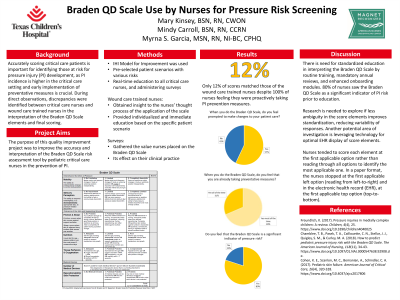Practice Innovations
(PI-025) Braden QD Scale Interpretation and Use by Critical Care Nurses for Pressure Injury Risk Screening

The purpose of this quality improvement project was to improve the accuracy and interpretation of the Braden QD Scale risk assessment tool by pediatric critical care nurses in the prevention of pressure injuries (PI). Accurately scoring critical care patients is important for identifying those at risk for PI development, as PI incidence is higher in the critical care setting and early implementation of preventative measures is crucial. During direct observations, discrepancies were identified between critical care nurses and wound care trained nurses in the interpretation of the Braden QD Scale elements and final scoring.
Methods:
The IHI Model for Improvement was used to drive the project by using pre-selected patient scenarios, providing real-time education to all critical care nurses, and administering surveys. Patient scenarios with varying risk were presented to the nurses for interpretation and scoring while observing response habits. The wound care trained nurses obtained insight to the nurses’ thought process of the application of the scale as well as provided individualized and immediate education based on the specific patient scenario. The surveys gathered the value nurses placed on the Braden QD Scale and its effect on their clinical practice, and feedback on the educational strategies used.
Results:
Only 12% of scores matched those of the wound care trained nurses despite 100% of nurses feeling they were proactively taking PI prevention measures. 79% of nurses saw the Braden QD Scale as a significant indicator of pressure injury risk prior to education. Nurses tended to score each element at the first applicable option rather than reading through all options to identify the most applicable one. In a paper format, the nurses stopped at the first applicable left option (reading from left-to-right) and in the electronic health record (EHR), at the first applicable top option (top-to-bottom).
Discussion:
There is need for standardized education in interpreting the Braden QD Scale by routine training, mandatory annual reviews, and enhanced onboarding modules. Research is needed to explore if less ambiguity in the score elements improves standardization, reducing variability of responses. Another potential area of investigation is leveraging technology for optimal EHR display of score elements.

.jpg)